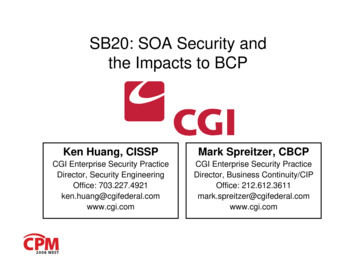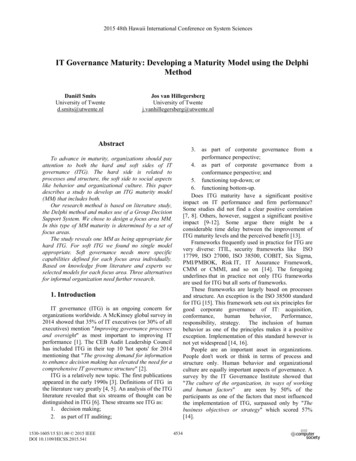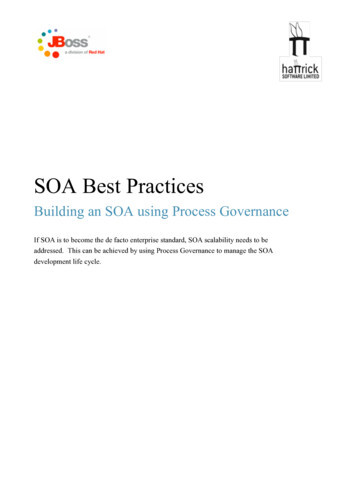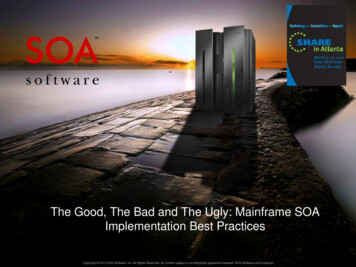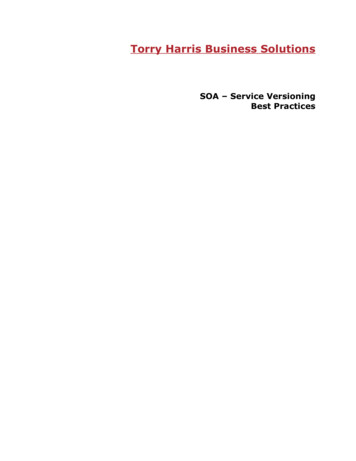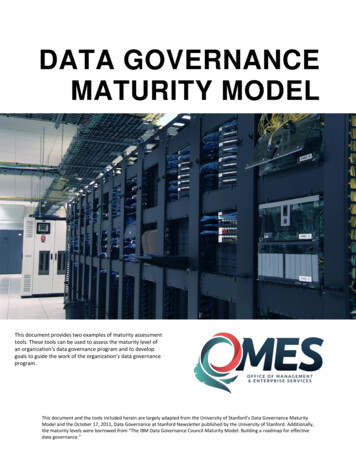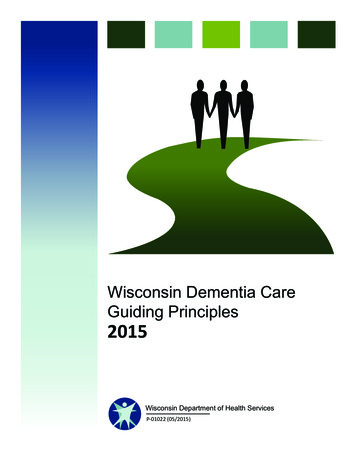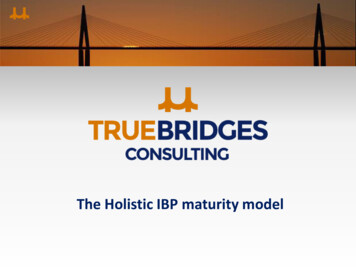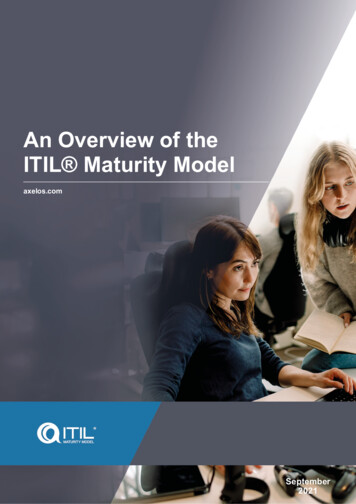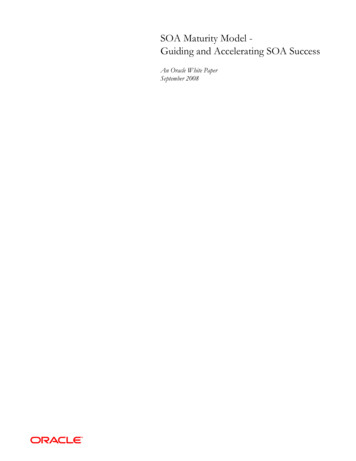
Transcription
SOA Maturity Model Guiding and Accelerating SOA SuccessAn Oracle White PaperSeptember 2008
SOA Maturity Model –Guiding and Accelerating SOA SuccessEXECUTIVE OVERVIEWThe Oracle SOA Maturity Model capturesyears of collective experience and bestService-Oriented Architecture (SOA) is not just another product or technology tobe added to the IT environment. Rather, SOA requires significant and often fairlyfar-reaching changes to truly reap all the benefits of adopting SOA. Tosuccessfully adopt SOA, a company must create a plan that addresses the fullextent of the changes required for SOA.practices for successful SOA adoption.For the past five years Oracle has been working with a wide variety of companiesthat are in various stages of SOA adoption. This experience has been captured inthe Oracle SOA Maturity Model such that this collective experience can be used tomeasure the progress of an SOA initiative and, more importantly, can identifyspecific capabilities that are lacking or lagging and are therefore inhibiting the SOAinitiative. A remediation approach for each of the identified inhibitors can bedetermined from industry best practices and prior experiences. These remediescan then be prioritized and used to create a plan, called the SOA Roadmap, to putthe SOA initiative back on track.An SOA Roadmap constructed byHaving an SOA Roadmap based on a comprehensive SOA Maturity Model that isconstructed using a proven approach and is based on years of collected experienceand best practices accelerates the SOA adoption and dramatically reduces the risksassociated with the transformation that SOA requires.application of the SOA Maturity Modelaccelerates SOA adoption and reducesrisk.INTRODUCTIONThis paper describes the Oracle SOA Maturity Model and how the model is usedto accelerate SOA adoption by identifying specific capabilities that are eithercompletely lacking or which are lagging with respect to the other capabilitiesnecessary for successful SOA adoption.SOA MATURITY MODELThe SOA Maturity Model defines the following key concepts: capabilities,domains, maturity, and adoption.Capabilities capture Oracle and industrybest practices for SOA adoption.Capabilities and DomainsThe SOA Maturity Model includes over ninety capabilities that capture the bestpractices that Oracle has collected over many years working with a wide variety ofcompanies. These capabilities provide the detail necessary to truly measure andguide the progress of an SOA initiative.SOA Maturity Model- Guiding and Accelerating SOA SuccessPage 2
The SOA Maturity Model categorizes thecapabilities into eight domains.Figure 1: SOA Maturity Model DomainsThe SOA Maturity Model uses the concept of domains to classify and organizethe related capabilities. As depicted in Figure 1, there are eight domains in thematurity model:Business & Strategy - Contains capabilities that provide the high-level constructsthat allow the SOA initiative to proceed. This includes such things as businessmotivation, expected benefits, guiding principles, expected costs, funding model,etc.Architecture – Contains capabilities concerning the definitions of the overallarchitecture and guidelines for various practitioners to ensure adherence to thearchitecture.Infrastructure – Contains capabilities concerning the service infrastructure andtools that provide the technical foundation for the SOA initiative.Information – Contains capabilities concerning the information aspects of SOA,e.g., providing Information as a Service (IAAS). This includes shared data models,message formats and schemas, master data management, content management, etc.Projects, Portfolios & Services – Contains capabilities concerning the planningand building of services and the service usage guidelines of service consumers.Operations, Administration & Management – Contains capabilities concerningthe post deployment aspects of solutions based on a service-oriented architecturei.e. the Operations, Administration, and Management aspects of SOA.Organization – Contains capabilities concerning the development of corporatecompetency around SOA including the organizational structure and skillsdevelopment.Governance - Contains capabilities concerning the governance structures andprocesses that support and guide the SOA efforts. Maturity and adoption of anadequate amount of governance is a leading indicator of the overall SOA success.These eight domains, although interrelated, are sufficiently distinct. To succeed atSOA adoption, an organization must adequate progress in all of these domains.SOA Maturity Model- Guiding and Accelerating SOA SuccessPage 3
Inevitably an organization will be more advanced in some domains (and further insome of the capabilities within a domain) than others. Therefore, it is important tobe able to measure the relative maturity within each domain (and capabilitiestherein) and across domains to identify areas that are lagging. Once the laggingareas have been identified it is possible to formulate remedies and thereby improvethe success of the overall SOA initiative.For example, an organization might have a Reference Architecture that was widelydisseminated, had been reviewed and accepted broadly, but lacked significantelements (e.g. service versioning strategy) required to provide a completearchitectural vision for SOA. Both having Reference Architecture and a serviceversioning strategy are best practices and both are therefore captured in the SOAMaturity Model as capabilities.For each capability included in the model, a description for each level of maturityand level of adoption is provided. Although there is always some level ofsubjectivity when measuring capability, these descriptions minimize the subjectivityinjected, and thereby provide, as best as possible, an objective measure of bothmaturity and adoption.There is still considerable debate on what constitutes SOA best practices (e.g.REST versus Web services); therefore, the SOA Maturity Model remainstechnology, standards, and product agnostic while still capturing the major tenantsof a complete SOA strategy.Additional capabilities are added as more best practices emerge. Thus, the detailsof the SOA Maturity Model will continue to evolve as more experience with SOAis gained. This allows the specifics to morph and improve as industry and Oracleknowledge of SOA advance.MaturityThe SOA Maturity Model defines six levelsof maturity to accurately measure SOAcapabilities.Within the software industry, maturity is frequently related to the CapabilityMaturity Model (CMM) and the CMM successor, the Capability Maturity ModelIntegration (CMMI). The SOA Maturity Model parallels this understanding andmeasures SOA capability against defined maturity levels. The levels of maturityused in the SOA Maturity Model (from highest to lowest) are:Optimized – Metrics are being consistently gathered and are being used toincrementally improve the capability. Assets are proactively maintained to ensurerelevancy and correctness.Managed – The capability is being measured and quantitatively managed via sometype of governance structure. Appropriate metrics are being gathered andreported.Systematic – The approach has been reviewed and accepted by affected parties.There has been buy-in to the documented approach and the approach is always (ornearly always) followed.SOA Maturity Model- Guiding and Accelerating SOA SuccessPage 4
Opportunistic – An approach has been decided upon and is beingopportunistically applied. The approach has not been widely accepted noradopted. It may be informally defined, or if documented, may exist primarily as“shelf ware”.Ad Hoc – Awareness of SOA exists and some groups are embarking on buildingservices. There is no SOA plan being followed.No SOA - There is no SOA approach being taken. SOA is not underway.The maturity levels progress from „No SOA‟ up to „Optimized.‟ These levelsdefine the path an organization usually takes moving toward SOA maturity. SOAby its very nature requires coordination, cooperation, and a common vision to besuccessful; therefore, it is necessary to define the strategy before it is possible to betruly successful at repeating it and then ultimately optimizing it.AdoptionThe SOA Maturity Model defines six levelsof adoption that measures how wide spreada capability is within the organization.Adoption measures how widely SOA is being accepted, embraced, and appliedwithin the enterprise. For smaller organizations within a single line-of-business,maturity and adoption are usually tightly related since there is a single approach toSOA being followed by the entire organization.However, within large companies with multiple divisions or lines-of-business thisis not usually the case. It is common to have one or more divisions that arerelatively mature in SOA while other divisions are not even attempting SOA. TheSOA Maturity Model handles these situations by providing a separate measure foradoption level. This allows a single division to be effectively evaluated for SOAmaturity while still capturing the lack of widespread adoption as a separatemeasure.For small organizations, it may be desirable to ignore the adoption dimensionaltogether and simply measure maturity. Conversely, for very large organizationswith a goal to achieving a broad SOA adoption, it may be desirable to measure thematurity for each division or line-of-business separately and then provide a singlemeasure of adoption across the enterprise. It should be noted, however, that forthe realization of many of the key SOA benefits, some level of adoption across theorganization is critical.SOA Maturity Model- Guiding and Accelerating SOA SuccessPage 5
Figure 2: SOA Maturity Model – Measures both maturity and adoption levelsThe levels of adoption used in the SOA Maturity Model are:Enterprise Level – The capability is implemented consistently across theenterprise i.e. all divisions or business units are applying the same approach.Cross Division – The capability is implemented by multiple divisions using acommon approach i.e. the approach is being shared or is spreading to multipledivisions.Division Wide - The capability is implemented consistently across a division orbusiness unit. A division or business unit is led by an executive at the VP level orhigher.Program Level - A relatively small group of projects (program) share animplementation of the capability. The program is under a single managementstructure below the VP level and encompasses less than an entire division orbusiness unit.Project Level - Individual projects implement the capability as appropriate forthat specific project. There may be informal and unregulated sharing acrossprojects.No Implementation - There is no current implementation anywhere in theorganization of the capability being measured.To be successful at SOA an organizationmust achieve the necessary level of bothmaturity and adoption for each SOAcapability.In order to properly measure the overall progress of SOA initiative in a largeorganization, the maturity of the individual capabilities and the degree of adoptionof such capabilities across the organization is vital. At this time, this approach isunique to the Oracle SOA Maturity Model.Maturity and adoption levels for some or all of the capabilities or for the domainscan be plotted as shown in Figure 2.SOA Maturity Model- Guiding and Accelerating SOA SuccessPage 6
APPLYING THE SOA MATURITY MODELA detailed assessment of an organization requires interviews of a variety of roleswithin the organization including executives, enterprise architects, developers,project and program management, operations, etc. The assessor then uses thedetails of the SOA Maturity Model to assign levels of maturity and adoption foreach capability. These scores can then be presented in a variety of formsdepending on the audience and the amount of detail desired.Figure 3: Spider Graph of Maturity and AdoptionFor example, a spider chart (Figure 3) can be created by averaging the maturity andadoption scores for the capabilities within each domain. This type of graphprovides a high-level view of the overall maturity and adoption for theorganization and can be used to highlight domains that are lagging with respect tothe other domains.The assessed values for maturity andadoption provide the initial state essentialto developing a multi-phase roadmap toachieve the SOA vision.The assessed values can also be used when defining a phased approach toimproving the SOA initiative. A key input to the phased approach is the level ofmaturity and adoption that the organization needs to achieve in order to meet thegoals of the SOA initiative. This level of maturity and adoption is called the„vision‟ for the SOA initiative. Figure 4 shows how the vision can be achievedover a multi-phase roadmap.Figure 4: Maturity and Adoption Over TimeSOA Maturity Model- Guiding and Accelerating SOA SuccessPage 7
Figure 5: SOA Roadmap PhasesThe bar chart in Figure 5 illustrates how maturity will improve based on twophases of the SOA Roadmap. It shows which domains are lagging and shows thatthese domains will receive the most attention in the first two phases of theroadmap.This level of detail is appropriate for an executive, but for the SOA programmanager, much finer detail is needed so that an actual plan for improving SOAcapabilities can be created. One such detailed graphic is the SOA capability heatmap as shown in Figure 6.The assessment provides detailedinformation on which capabilities requireimprovement to meet the needs of the SOAinitiative.The graphic in Figure 6 illustrates the maturity via color coding for each capabilitye.g. the red colored capabilities have a maturity level of „No SOA‟. For example,the above graph shows that within the Governance domain, there is no capabilityfor governance of service development. Clearly this is then an area that requiresimprovement and that improvement plan becomes part of the SOA Roadmap.Figure 6: SOA Capability Heat Map (domain Governance highlighted for illustration)SOA Maturity Model- Guiding and Accelerating SOA SuccessPage 8
The true value of applying the SOA MaturityModel to assess an SOA program is in thedetailed measurement of the SOAcapabilities that can be used to accelerateSOA adoption and reduce risk.Figure 7: SOA Capability Scatter PlotPlotting maturity versus adoption can also illustrate some capabilities of interestsas shown in Figure 7. This graph plots the maturity and adoption for all of thecapabilities on a single scatter plot. Of particular interest are the outlier scoressince these tend to be either areas requiring improvement (closer to either axis) orareas showing excellence (farther away from the origin). For example, a score withhigh adoption value and low maturity may indicate a wide usage of a poor practice(with its potential negative effects) while a score with high maturity and lowadoption values may indicate an opportunity to spread a well-understood bestpractice that could be embraced by more organizational units fairly quickly i.e. aneasy win.The graphs described are only a representative sample of the types of graphs thatcan be created to analyze and present the SOA capability scores. The real value isnot in the graphs per se, but rather the detailed, accurate, complete measurement ofthe progress of the SOA initiative which can be used in a variety of ways toimprove the success of the SOA initiative.CONCLUSIONSOA can reduce integration cost, increase asset reuse, increase business agility, andease regulatory compliance. Achieving these benefits requires a systematic,widespread, holistic, and proficient application of SOA best practices.The Oracle SOA Maturity Model includes more than ninety capabilities that reflectindustry and Oracle best practices. This provides the details necessary toaccurately measure the progress of an SOA initiative. The measurement of theSOA implementation progress can be analyzed to find areas that needimprovement. These areas can then be addressed by applying industry and Oraclebest practices to increase the success of the SOA initiative and drive greater valuefor the organization.SOA Maturity Model- Guiding and Accelerating SOA SuccessPage 9
SOA Maturity Model – Guiding and Accelerating SOA SuccessBob HensleManas DebSeptember 2008Oracle CorporationWorld Headquarters500 Oracle ParkwayRedwood Shores, CA 94065U.S.A.Worldwide Inquiries:Phone: 1.650.506.7000Fax: 1.650.506.7200oracle.comCopyright 2008, Oracle and/or its affiliates. All rights reserved.This document is provided for information purposes only and thecontents hereof are subject to change without notice.This document is not warranted to be error-free, nor subject to anyother warranties or conditions, whether expressed orally or impliedin law, including implied warranties and conditions of merchantabilityor fitness for a particular purpose. We specifically disclaim anyliability with respect to this document and no contractual obligationsare formed either directly or indirectly by this document. This documentmay not be reproduced or transmitted in any form or by any means,electronic or mechanical, for any purpose, without our prior written permission.Oracle is a registered trademark of Oracle Corporation and/or its affiliates.Other names may be trademarks of their respective owners. 0408
There is still considerable debate on what constitutes SOA best practices (e.g. REST versus Web services); therefore, the SOA Maturity Model remains technology, standards, and product agnostic while still capturing the major tenants of a complete SOA strategy. Additional capabilities are added as more
